What determines the quality of a meal served in a restaurant? More than anything, it is the skill of the chef who prepared it and the ingredients used to prepare it. The same principle applies to 3D printing. The technical skill of the builder and the materials used will determine how the build turns out.
Good quality filament will always produce better builds than substandard filament. There is a higher likelihood of producing consistently good prints using filaments from a good brand than from an inferior brand.
The brand of filament matters because good brands invest more in the quality of their product. They are incentivized to maintain a good product by a market that buys a good product. An inferior brand will often not invest in innovating the product and is more likely to compete on price and not quality. This leads to a poorer quality filament that produces bad prints.
In this article, we look at how to differentiate between good and bad quality filament. We examine some of the things you should look out for when buying filament for your next print. We also look at whether you can mix different brands of filament.
On a side note! If you’re looking for a reliable and high-quality 3D printer, we highly recommend the Official Creality Ender 3 V2 Upgraded 3D Printer (Amazon Link).
This printer is an upgraded version of the popular Ender 3 model, with a range of new features and improvements that make it even easier and more convenient to use.

If you want to avoid wasting money on spools of bad filament, then this guide will give you the tools you need to be able to sift those out.

What Is A Good Brand Of Filament?
Some of the best filament brands on the market include Hatchbox, Polymaker, Prusament, and Matterhackers. These are industry-leading brands known for producing a wide variety of good quality filaments at reasonable prices.
There are several other competing brands like Eryone, Paramount, and Fillamentum that also produce good quality filament. Besides going on name alone, what should you look for in filament?
When looking to buy filament, you should look at the composition and tolerance of the filament.
Composition
This is the element the filament is made of. This could be PLA, ABS, Nylon, etc. However, the filament is rarely composed of one element. It will always have an additive that is used to give the filament a certain color or to make it more adhesive. In that sense, additives are not necessarily bad.
Some manufacturers will sometimes mix cheap additives just to make more filament and cheapen their production costs. It is this type of filament filled with non-value-adding additives that you want to avoid.
Tolerance
Filament comes in two diameters. It can be either 1.75mm or 2.85mm. The thickness throughout a spool of filament will vary. A good quality filament should have less deviation or a tolerance no greater or lesser than 0.05mm of the stated width.
Brands like Hatchbox and Prusament advertise that their filament spools have a deviation of less than 0.03mm.
Composition and tolerance are the two main factors you need to look out for. Other things you should note are the consistency of the color and the smoothness of the filament. The good filament shouldn’t have splotchy or streaky color. Except for exotic filaments, it should also be smooth to the touch.
Can You Mix Filament Brands?
It is possible to mix filament brands provided the filament is of the same quality. Mixing quality filament from a good brand with poor filament from an inferior brand is likely to produce failed prints due to the difference in material composition.
It’s important to experiment beforehand, however. Different brands might use different chemical compositions in their filament. This might affect the temperatures at which their respective filament needs to be extruded.
This means you might have to adjust depending on the filament from a particular brand which introduces complications in your prints. Source
Does It Matter What Filament You Use?
The filament used determines the quality of a print. Certain brands of filament consistently produce better prints. Different types of filaments have unique properties that give them specific strengths and weaknesses more suited for different types of prints. PLA for example does not hold up as well to high temperatures as Nylon.
Technical expertise is important for learning a craft of any kind. One way to improve your skill is to know about the tools and materials at your disposal. Not all filaments are the same. There are different types of filaments and where one might excel, another might not work as well.
There are more than 25 types of filaments to choose from with more coming out to meet the increasingly diverse demands of a growing 3D printing industry.
Basic filaments
These are the most used filaments. They are popular because they can be used for just about anything. They are cheap, easy to use, and the easiest to find. Basic filaments include:
- PLA
- ABS
- PETG
- TPE, TPU, TPC
- Nylon
- PC
Some of the most popular uses for basic filaments are phone cases, toys, tool handles, and even bulletproof glass.
Exotic filaments
While basic filaments are more recognized for their functional qualities like strength and durability, these types of filaments are preferred more for their aesthetic appeal or unique physical property. Alternative filaments include:
- Wood-filled
- Metal-filled
- Glow-in-the-dark
- Color changing
- Conductive
- Magnetic
- Dichromatic
- Ceramic/Clay
Alternative filaments are great for achieving a specific look or purpose. They are typically used for making pottery, toys, and wearables. Source
Professional filaments
These are filaments typically used in commercial or industrial applications. This is not to say you can’t use basic or exotic filaments or that these are the only ones suited for those applications. Nor does it mean they can’t be used by hobbyists. They’re just typically more expensive and not as readily available. Professional filaments include:
- Carbon fiber
- Glass fiber
- Metal
- HIPS
- PVA
- High speed/Draft
- Wax/Castable
- ASA
- Polypropylene
- PC ABS
- Acetal
- Acrylic
For more on this, check out our post Can You Use Weed Eater Line In A 3D Printer as Filament? All 3D Printing Filament Types Listed!
Professional filaments can give you more strength, greater durability, or faster flow rates. Your choice of filament depends on what you are looking to achieve with your print. But how does the brand impact your choice?
Is There A Difference In PLA Filament?
PLA is the most popular filament for both beginner and more experienced users. What distinguishes PLA is its versatility, lack of odor, and ease of use. PLA filaments come in a variety of blends, colors, and properties and can be used to make everything from toys to prototypes.
The main drawback of PLA is its brittleness. It does not have the flexibility of a nylon filament or the impact resistance of ABS for example.
